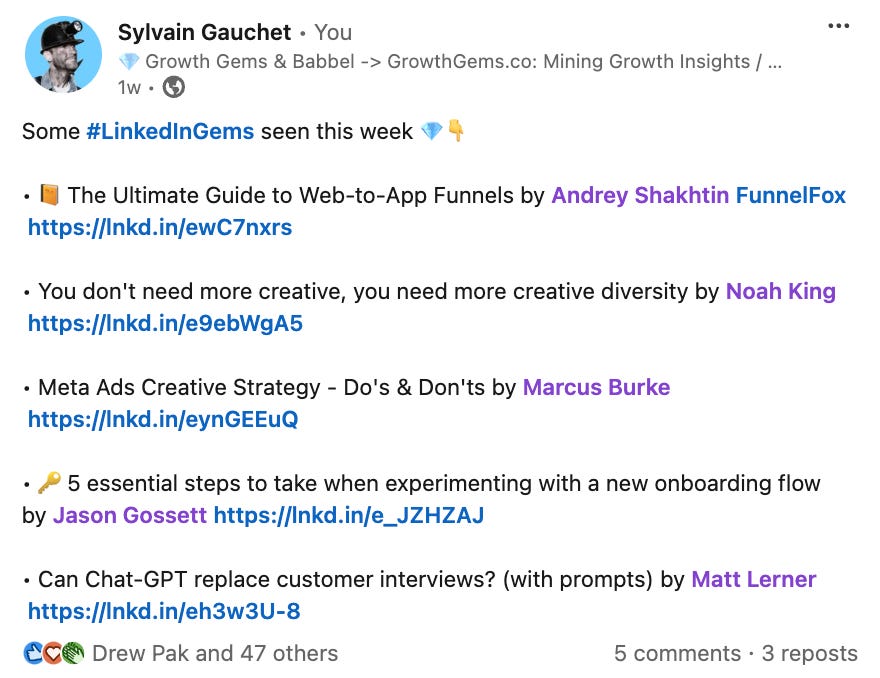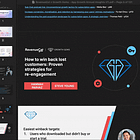Hi, fellow growth practitioner!
I mine hundreds of gems each month ⛏️ and store them in the Growth Gems Vault.
I can’t share them all. Plus, I know you’re busy.
This monthly digest is the ONE email to read if you can’t read any other from me. And if you can read everything I send, you’ll still discover some exclusive gems and the videos/podcasts where they were shared.
Enjoy!
#LinkedInGems
Earlier this year, I started curating and sharing my favorite LinkedIn posts weekly.
Below are the ones for this month (click on the image to get to the post)!
Top gems
I examined this month’s gems to present you with my favorites.
This was SO MUCH HARDER than I thought it would be.
I decided to keep only the ones where I either learned something or have been not paying enough attention and needed to revisit my point of view. This means I had to take out a few great gems on fundamentals.
Because of App Growth Annual, I am sharing a top 20 this month instead of a top 10-15.
💎 Do not focus on increasing app engagement for your subscribers until you confirm that higher engagement rates are correlated with higher retention rates. For example, at Masterclass, that wasn’t the case.
(07:50) by Thomas Hopkins
💎 Building a “starter kit” email onboarding program that focuses on key actions users need to take to be set up for success can help you increase CRM’s impact on M1 retention.
Example: 14 days program at Lifesum.
(04:15) by Karan Tibdewal in How Lifesum 2x'd Their Impact on M1 Retention by CRM: Case Study
💎 Communication is constantly underrated: it’s about conveying a message so that the listener receives it, understands it, and remembers it.
Example for Duolingo: having a unique voice, always having a quirk, and not taking themselves too seriously.It’s about how they make users feel and use that to their benefit. When writing, ask yourself, “Could this have been written by another company?”
(49:45) by Gina Gotthilf in Scaling Duolingo, embracing failure, and insight into Latin America’s tech scene
I love that last line.
💎 Try “strategic losing” in your ASA campaign: when you lose volume on a keyword after decreasing bids gradually, increase back your bid each hour until you get back impressions.
(33:34) by Hamilton Radcliff in Using Strategies Rather Than Tactics to Purchase Apple Search Ads
💎 If you have a content app, plug in your content database to Facebook’s catalog API (it’s usually for eCommerce) and use custom audiences to retarget potential churners with ads showing continuously new content.
(13:20) by Hannah Parvaz in How to win back lost customers: Proven strategies for re-engagement
If you’re wondering, Hannah still does this post-ATT.
💎 Implement cart abandonment push notification reminders for users who saw your paywall after trying to access a feature or content. Don’t worry about annoying your users, and don’t hesitate to have multiple reminders. Example: Zinio went from 2 reminders (1 hour later, then 2 days later) to 3 reminders (1 hour later, 1 day later, and 1 week later) and 13x their conversion.
(41:00) by Steve Young in How to win back lost customers: Proven strategies for re-engagement
💎 The key in the early days is to figure out product-market fit, not to worry about other areas. So, when you have 100 subscribers and you want to grow further, the next step is to pick up the phone and talk to as many of your best users as you possibly can.
(51:40) by Phil Carter in Scaling Beyond $10M: Sustainable Growth Strategies for Subscription Apps
💎 Once you understand the audiences that convert better based on Meta’s breakdowns and your first-party data (e.g., older users, gender, user goals/motivation, etc.), use what you know that Meta doesn’t to create your campaign splits to “force budget” onto different segments in different ways.
(25:30) by Marcus Burke in Advanced Meta Ads strategies for subscription apps
Use what you know that Meta doesn’t. I think that sums up very well a lot of Marcus’ approach.
💎 In the beginning, tests big creative swings with very different creative types/styles so you can tap into different placements. You’re looking for the most relevant Placement x Audience combination. Testing only different static styles and messaging might result in running ads only on Facebook and you might not learn what you need.
(30:40) by Marcus Burke in Advanced Meta Ads strategies for subscription apps
💎 When you find new creative wins, start using them in your “business as usual” campaign in a strategic manner:
If it’s performing “only” 5% or 10% better than your current creative winner, keep it in the backlog to not interfere with the algorithmic learning. Wait for when you see fatigue or struggle to scale.
If it’s performing very significantly better, either put it in your “business as usual” campaign, scale the ad set it’s in, or create a new ad set (if it’s a new “category” of creative type)
(46:05) by Marcus Burke in Advanced Meta Ads strategies for subscription apps
💎 Measure and promote word of mouth through the Word of Mouth Coefficient (by Yousuf Bhajiee): WoMCo = New WOM Users / (Returning Users + New Non-WoM Users)
Understanding the evolution of this ratio over time helps you learn about seasonality (e.g., for Quizlet during back-to-school and exam periods) so you can drive more Word of Mouth through product and marketing efforts during those periods.
(48:17) by Phil Carter in The Subscription Value Loop: A Framework for Growing Consumer Subscription Businesses
My initial reaction was that the formula makes sense, but the difficult part is to define “New Organic Users”…
The article suggests to use “Direct + Brand Search” GA sources. I also look into the “How Did You Hear” question from onboarding.
💎 The dogmatic rule of monetization is to monetize upfront. But you can also reach local maxima this way, particularly if the activation requires specific actions (e.g., reaching a friend count). In this case, you might need to prioritize activation first in order to maximize network effects.
by Nikita Bier in Sub Club podcast live: Unconventional growth tactics for subscription apps
For an app with network effects, you want to be on the left side of the freemium <> premium spectrum.
💎 A lot of apps don’t use progressive design: they don’t change the design based on the user's state or the state of the community they’re operating in. Your app can look different based on the stage of the user lifecycle and state of the community/network.
by Nikita Bier in Sub Club podcast live: Unconventional growth tactics for subscription apps
I shared some examples from Headspace and Impulse here, that at least do that after the paywall.
💎 Often times, when analyzing conversions or understanding activation moments, you’re looking at the quantitative view. Looking at it qualitatively as well will help you find the maximas by manufacturing the important moments. Example: TBH/Gas prioritized certain polls to improve conversions, chatbot products leverage the discussions that get screenshotted the most.
by Nikita Bier in Sub Club podcast live: Unconventional growth tactics for subscription apps
It’s easier to just look at the data, but it means you might miss opportunities to increase conversions.
💎 Setting up a live chat for user feedback in your app to provide a “direct line” will help you learn more than running a/b tests. It helps you identify bug, understand pain points, and gives the “white glove treatment” to all users.
by Nikita Bier in Sub Club podcast live: Unconventional growth tactics for subscription apps
Steve Young mentioned Crisp.chat a couple of times, and then of course you have tools like Intercom, Drift, etc.
💎 For referrals, limit the number of invites that people can send and/or the duration during which they can invite. They are more likely to invite if there is a finite number of available vs. unlimited.
💎 Use Anchored Juxtaposition: put side-by-side the possibility to pay to unlock AND grind to unlock. Most people will do the grinding, but after a while they will end up paying. Example: Dropbox with steps to gain additional space.
💎 When testing a first gaming ad network (AppLovin, Vungle, etc.), you need to have the right expectations for the learning curve: assume the first $50k are lost, and evaluate the channel with the next $50k. Hire a gaming person that has previous experience in managing publishers, creatives, etc.
by Thomas Petit in Onboarding & Monetization for Subscription Apps - What's Working?
💎 TikTok is amazing because it allows you to test a lot of creatives. Before testing paid TikTok, throw all the videos you can create into an organic account, and only start paid if something works there.
by Thomas Petit in Onboarding & Monetization for Subscription Apps - What's Working?
💎 The conversion behavior of users during onboarding and post-onboarding is different.
You probably want a different paywall for the two
When you a/b test your paywall, separate the analysis between the onboarding paywall and the post-onboarding paywall(s).
by Thomas Petit in Onboarding & Monetization for Subscription Apps - What's Working?
💎 Put your best content for free. Paid users typically don't know what's gated or not, and it shows the best value to everyone.
by Thomas Petit in Onboarding & Monetization for Subscription Apps - What's Working?
Top resources
Below are my top 3 resources for webinars, talks, and podcast episodes I mined. These are a must-read in my opinion.
Thomas Petit’s Onboarding & Monetization for Subscription Apps - What's Working? at App Promotion Summit SF
Nikita Bier’s Sub Club podcast Live at RevenueCat’s App Growth Annual
Marcus Burke in the RevenueCat webinar Advanced Meta Ads strategies for subscription apps
And here is everything else I mined…
Understanding the paid acquisition landscape for subscription apps: A strategic overview - Thomas Petit’s workshop at App Growth Annual
Applying the Octalysis Framework - Yu-Kai Chou’s talk at App Growth Annual
They clicked on my ad, now what? How to optimize landing pages and onboarding - Gina Gotthilf at App Growth Annual
Finding success on Google Play: Android buyer insights and revenue optimization strategies - Tammy Taw at App Growth Annual
The Subscription Value Loop: A Framework for Growing Consumer Subscription Businesses - Phil Carter at App Growth Annual
Advanced Meta Ads strategies for subscription apps - Marcus Burke in a RevenueCat webinar
Scaling Beyond $10M: Sustainable Growth Strategies for Subscription Apps - Phil Carter in a RevenueCat webinar
How to win back lost customers: Proven strategies for re-engagement - Hannah Parvaz and Steve P. Young in a RevenueCat webinar
How to Profitably Expand Your Subscription App in an Increasingly Cutthroat Market - Bahar Bölükbaşı at App Promotion Summit London
How Lifesum 2x'd Their Impact on M1 Retention by CRM: Case Study - Karan Tibdewal at App Promotion Summit London
Applying Cognitive Bias to Change Engagement and Monetization - Angèle Lenglemetz at App Promotion Summit London
Using Strategies Rather Than Tactics to Purchase Apple Search Ads - Hamilton Radcliffe at App Promotion Summit London
Non-Obvious Ways to Grow Your App Revenue - Vahe Baghdasaryan and Ekaterina in a GrowthMentor webinar
Holistic Engagement Strategy - Vahe Baghdasaryan at MAU Vegas 2024
Practical Tips for improving app user retention in CRM - Jacob Rushfinn in an Aampe webinar
Building a Winning Customer Engagement Program - Melissa Worthington at Forge 2023
Scaling Duolingo, embracing failure, and insight into Latin America’s tech scene - Gina Gotthilf in Lenny’s podcast
Strategic Analytics for App Growth - Jeff Wang in the Business of Apps podcast
Taking Preventative Measures for Subscriber Churn - Vahe Baghdasaryan at App Promotion Summit SF
PANEL: User Acquisition for Subscription Apps - Zamir Wassermiller at App Promotion Summit SF
Reward Schemes Using Advanced CRM to Retain Subscribers - Karan Tibdewal at App Promotion Summit SF
That’s it for this month, see you next time.
Stay curious!
⛏️ Sylvain

















